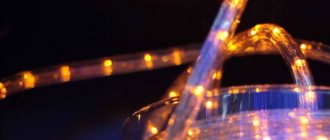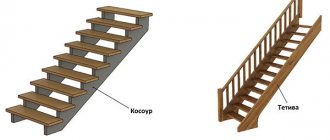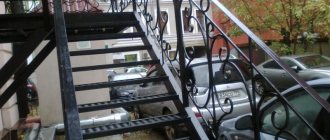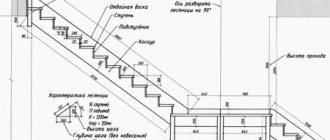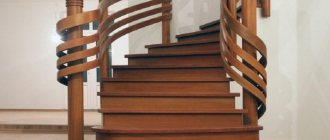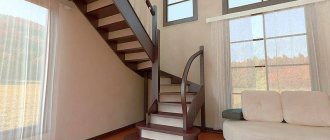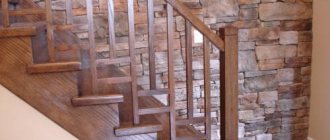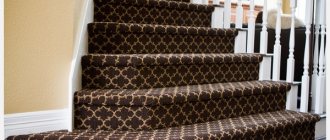A country house is undoubtedly a convenience. But if it is two or three stories high, it has a staircase, which means there is a possibility that the residents of the house may accidentally fall from it in the dark. Automatic staircase lighting helps solve this problem. Modern technologies can not only provide lighting for the entire staircase, but also for each step separately. At the same time, a pleasant soft light will not dazzle the eyes, which not only ensures safety, but also adds an additional element of aesthetics to the design of the entire house.
Beauty, safety, savings
Automatic lighting gives a very impressive appearance. In addition, the safety of movement increases. In addition to this there are other benefits:
- There is no need to feel for a switch on the wall in pitch darkness.
- Even if only slightly, energy is saved. Due to automation, the system is in an economical standby mode.
- Using automation tools when installing lighting, you can set up beautiful visual effects.
And you don’t have to worry that it’s expensive and inaccessible to an inexperienced user. The entire set of additional lighting is initially very inexpensive, and can easily bring additional comfort and benefit to residents.
Wall lamps: their types, advantages
Side light is a win-win option for wall-mounted stairs.
A string of wall lamps can complement ceiling lighting or be used independently. And, if installed correctly, the entire flight of stairs will be illuminated evenly and elegantly.
The general principles are:
- The lamps must be placed no lower than human height;
- between the devices, make equal moderate gaps of about 1-1.5 m, with the expectation that the light spots should merge and illuminate all areas of the stairs;
Photo source
- plus the luminous flux must necessarily fall down onto the steps;
Photo source
- It is also desirable that the lamps complement the overall atmosphere and style of the interior.
There are only 3 basic options for such devices.
1) Wall sconces with a small bracket.
2) Surface sconces - models that are attached directly to the wall.
3) Built-in LED lights, invisible, creating beautiful effects.
How automatic backlight works
What’s good about this type of auto-backlight is that it’s independent. She herself will determine when and for how long to turn on the light. Due to the fact that the circuit includes motion sensors, they will react to the appearance of a person and turn on the lighting either of the entire staircase at once or of each step separately. It is better to provide two motion sensors in the circuit - at the beginning and at the end of the flight of stairs. This way the system will determine that after a person passes the light can be turned off. Also, the power circuit is necessarily supplemented with controllers that can be programmed for different response conditions. An additionally installed sensor for turning on the light when darkness sets in will allow the operation of motion sensors and prevent the backlight from turning on if the lighting level in the room is high enough.
In case the stairs in the house are very long and have several flights, it is possible to install additional sensors. It's even more interesting this way. The connection circuit can be complicated:
- Include not all stages, but several - in groups;
- Or one step along the route of a person’s movement.
What light sources are most practical?
When choosing staircase lighting in your home, it is important to become familiar with the characteristics of various lamps. Knowing the pros and cons will help you evaluate different options and choose the best one. The following types of sources are allowed:
- Incandescent lamps. Due to their low cost, they still remain popular, despite the high heat and wasteful energy consumption.
- Halogen. They are distinguished by bright, even light and are used in chandeliers or sconces. They are not suitable for local illumination of steps (especially wooden ones) due to their brightness and rather noticeable heating. Halogen lamps are sensitive to voltage surges.
Combining three types of lamps Source pinimg.com
- Neon (gas discharge). The color of the dump depends on what gas is inside. Neon has a red-orange glow color, but in principle it can be anything. Models in the form of tubes are used for longitudinal illumination of steps; the light is soft and does not hurt the eyes. The lamps last a long time, but require delicate handling.
- LED. Popular due to their stable bright glow, low energy consumption, and variety of assortments. They have an impressive service life and are suitable for installation on wooden elements, as they practically do not heat up. Available in different forms: lamp, point source, tape.
Recessed LED luminaires Source diodeled.com
Selecting lighting sources
The most common option is LEDs.
The most affordable models that emit light of one tone.
More expensive LEDs with RGB backlighting. Such LEDs produce light of any shade that the controller sets for them.
Due to the fact that LED strips of both types operate from a 12 V mains voltage, do-it-yourself automatic staircase lighting is absolutely safe to use. In addition, the installation of the staircase lighting system itself is possible on your own without special equipment.
Ceiling lights above the stairs: 3 options
The main requirement for any ceiling lamp is that it must provide diffused and (as far as possible) uniform and pleasant lighting.
Here are a few examples of the successful use of overhead lighting over a flight of stairs.
1) Large chandelier, classic or elongated.
A chandelier is most appropriate in a spacious house with high ceilings and classic furnishings.
It would look harmonious, for example:
- model with cascading suspensions;
- a lamp stylized as an antique street lamp, preferably with several shades;
- the most luxurious solution is a mega-luminaire, the so-called “span” chandelier, from 1 to 3 meters long.
"Span" classic chandelier
2) Cascade of chandeliers.
With the help of a cascading wave of lamps, you can stylishly highlight a staircase opening and at the same time create uniform, pleasant illumination. Ball lamps or long spots will look very trendy.
Photo source
This lighting is suitable for medium or high staircases.
3) LED lamps.
This is already a trendy minimalist lighting option, ideal, in particular, for low houses with laconic stairs.
Preparing for installation
If there is no ready-made kit for lighting the steps of the stairs, you need to think through the lighting scheme yourself. It's not difficult at all. In this age of the Internet, you can find almost everything on this topic.
If you have already decided where all the necessary elements will be placed, it is best to sketch out a small drawing on a blank sheet of paper with connection elements with their installation locations directly on the stairs. This will give you a clearer picture of the future outcome of your project.
Knowing the initial dimensions of the room, the dimensions of the stairs and flights of stairs, it is not difficult to calculate both the footage of the LED strip and the number of sensors that will work in the future lighting system.
This type of lighting scheme is often found on the Internet:
This scheme is quite workable if you use a regular and inexpensive strip of LEDs. Although there is a significant drawback to it. It is necessary to install a special controller for each piece of tape. That's how many steps there are, that's how many sections of LED strips there are. Each strip needs its own output and all the wires are combined together. Therefore, already at the output of the controller you get an impressive braid of wires.
But the most interesting effects are provided by the addressable RGB LED strip. In addition to simplifying the scheme, we will get the color design of the steps with a variety of color effects.
If anyone doesn't know, we'll explain. The addressable LED strip makes it possible to control a separately soldered LED. And each LED in the strip is capable of producing about 16 million different shades!
A more simplified diagram of the project “staircase lighting on steps with a motion sensor” can be presented in this version:
Now about the details.
Addressable type light strips are highly directional and are connected to the DI pin.
As can be seen from the example, all separately cut strips of tape are connected through D0 to DI.
We recommend using ws2811 chip strips to illuminate small flights of stairs.
Tapes of this type can be powered from a 12 V source. Every three LEDs in this strip are controlled by their own chip, which produces a certain light on the 3 LEDs for which it is responsible.
We advise you to buy a roll of tape (or as much as you need according to your calculations) on the Chinese trading platform Aliexpress. You will not lose in quality, but you will definitely gain in price. For some reason, in our retail chains similar tapes cost orders of magnitude more than in China.
At the time of writing, a five-meter roll of tape with a density of sixty diodes could be purchased for only 700 rubles.
A denser arrangement of LEDs is also on sale, and costs more. But for staircase design there is no point in buying such a strip, since 60 LEDs per meter is the optimal parameter for illuminating steps.
Now we need to talk about one more parameter.
There are tapes on sale with different degrees of moisture protection - IP:
- IP30 without protection;
- IP65 - silicone coated tape;
- IP67 - sealed tape in a silicone casing.
It doesn’t make much sense to buy IP67 for indoor stairs, but illumination of stair steps from IP30 or IP65 is at the discretion of the owner. It seems to us that giving preference to IP65 would be wiser. Do you still need to wash the steps sometimes?
Here on Ali Express you can find the bright tape. It will cost an order of magnitude more, but you will benefit from the power of the luminous flux - the light will be much brighter.
Immediately on Ali you need to select a microcontroller to control the tape. We recommend paying attention to similar devices on the Arduino Nano platform.
Lighting fixtures: how to choose and where to install
Lighting for a flight of stairs is selected at the design stage of the house, because it is required not only to be functional, but also to match the design of the staircase and the rest of the interior. Manufacturers offer a wide selection of lamps, and almost all are suitable for organizing staircase lighting.
Lighting should be consistent with the overall design Source cloudfront.net
Spotlights
The small size allows these products to be effectively used for organizing any form of lighting. A feature of point models is the creation of a directional light flux.
Depending on the characteristics of the lamps, the light can have different color temperatures, which is used to achieve different visual effects. Cool shades visually expand the space, while warm tones create a feeling of comfort.
Using spotlights Source enzie.com.au
For stairs with illuminated steps, several LED layouts are offered: through one or two steps, in the center or on the sides. Spotlights are used in the following parts of the structure:
- On the wall along the steps. If network lighting is planned, a method for masking the wiring and creating niches for the devices themselves must be thought out in advance. The easiest way to do this is on a plasterboard surface.
- In the risers. Useful lighting will be obtained if you place point elements in the risers (vertical elements). This solution allows you to get rid of distortion of the contours of the steps.
- On the steps. Installation on the horizontal surface of steps is carried out quite rarely. Here they choose less powerful products that do not irritate the eyes at night.
An eye-catching location Source chewjoinery.co.uk
LED strips and neon tubes
Flexible tape is a popular way to break up the darkness in a stairwell. Like all other LED-based products, the strips are economical in energy consumption, do not heat up to dangerous levels and are mounted according to a simplified scheme.
The tape, due to its plasticity, is fixed on a surface of any shape using an adhesive base; sometimes a metal profile is used. Traditional mounting locations: wall along the stairs, edge of steps, under railings.
Neon tubes are also used to create illuminated stairs. They are elastic, last a long time and create a pleasant diffused light that does not strain the eyes at night. Unlike LED strips, neon tubes create circular rather than directional light.
Creative solution to a problem Source pinimg.com
Required tools, components and materials
Let’s summarize what we may need to continue the DIY automatic staircase lighting project:
- Ready-made Arduino Nano control board;
- LED strip with or without a motion sensor, addressable type;
- A pair of infrared motion sensors;
- Light sensor;
- 12V power supply;
- Soldering iron;
- Device for removing insulation from wires;
- UTP wires.
How to choose a backlight: 4 useful criteria
Staircase lighting will be practical and of high quality if the following criteria are taken into account when choosing:
- Backlight level. If the staircase area has access to natural light, you can choose low-wattage lamps and reduce their number.
- Economical. Stairs are used regularly, so smart staircase lighting with sensors that are triggered by movement or sound would not hurt.
- Autonomy. It is useful if there are occasional power outages.
- Brightness of lamps. The lamps are positioned so that the light does not interfere with movement. For long flights of stairs, it is better to provide diffused lighting.
It is important not to overdo it with brightness Source futurecdn.net
Where can I buy
You can purchase equipment for creating lighting either in a specialized store or online in an online store. In the second case, the budget option for purchasing products on the Aliexpress website deserves special attention. For some video cameras there is an option for shipment from a warehouse in the Russian Federation; they can be received as quickly as possible; to do this, when ordering, select “Delivery from the Russian Federation”:
| Compatible Arduino Nano controller with bootloader | Wireless LED strip with motion sensor | IR sensor HC-SR501 |
| Light Sensor Module LM393 | Power supply 5,12,24,36,48 Volts | Digital electric soldering iron |
Dimmer, RGB controller and amplifier for staircase lighting with ice tape
Additional equipment will be needed in three cases:
- Brightness adjustment is required - install a dimmer;
- multi-color ice tape is used - an RGB controller is installed;
- The dimmer/controller power is not enough - an amplifier is added.
All these devices are connected to an electrical circuit between the power supply and the tape. Connection options are shown in the figures:
Sensors
We install one motion sensor at the beginning and end of a flight of stairs.
We recommend that you learn more about how to adjust the motion sensor if you are using a non-programmable version of the device.
Our infrared motion sensors for turning on the lights on the stairs are quite functional, but the installed caps narrow the viewing angle. Therefore, we get rid of the caps and leave the sensor itself. In order for it to turn on when approaching the steps, it is advisable to even deepen it a little during installation in order to further narrow the viewing angle. Thus, it will react to movement precisely when approaching and leaving the steps.
Another light sensor wouldn't hurt. Thus, we get automatic control of the brightness of the backlight so that it does not blind the eyes after dark.
The final system diagram looks like this:
Preparing the controller
What is a controller with Arduino based driver chips? This is a microcontroller with many ready-made settings and hardware modules.
In order for it to work in the desired mode, it needs to be programmed. Suitable firmware with download instructions are freely available on the Internet. Below is also a sketch of the program, you can download the sketch here: https://cloud.mail.ru/public/5GtW/5M5CvRwLc
We take our Adruino scarf and connect it to a computer or laptop. Go to the Arduino IDE and click on the “Download” button.
Once the selected firmware is downloaded to the board, we can begin the final assembly of our entire backlight circuit.
DIY lighting installation
After assembling the circuit, checking it in test mode, and if it is functioning properly (you can see how the assembly process works from photo reports on the Internet), you can begin the most labor-intensive work - installing and connecting the light source with your own hands.
You will also be interested to learn about double-flight stairs, which are described in this article.
Light control circuit.
Installation of light strips is very simple:
- Using scissors, a section of tape of the required length is cut along the marking line.
- A special connector is attached to one of the extreme sections of the piece of tape, and two wires are connected to it.
- The steps on which the tapes will be mounted must be degreased. For this, acetone or any other solvent is used.
- The protective shell is removed. The LED is applied to the lower base of the step with the self-adhesive side.
- The wires must be placed under the stair structure through a small slot in the riser.
Installation of recessed lamps is a little more complicated. For this:
- Using a hammer drill, you need to drill holes in the wall for the housings, as well as make ledges into which the wires will be laid.
- Socket boxes are installed in the prepared holes along with special casings that are equipped with the lamps.
- Lamps are installed, the fixation of which is carried out using clamping screws.
- The wires should be laid in plastic cable channels, and the ledges should be sealed with cement mortar.
A similar scheme is used for installing sensors on the outer steps of a staircase structure.
Stages of work
Once we have all the necessary components, we can begin installing the entire circuit. It is probably better to first assemble the entire sequence of components on the floor, check its operation, and after making sure that everything works as it should, you can begin installing all the elements directly on the stairs.
So, the stages of work:
- But first we need to cut the LED strip into the required lengths.
- It is necessary to solder the stripped ends of the wires to them at the required points on the tape.
- At the edge of each piece of LED strip there are marked points (D0 and DI). Wires are soldered to them in a certain order.
Important! When soldering wires, observe polarity.
- Protect the soldering areas with a plastic tip.
Checking the circuit
After the circuit is soldered, it’s time to check the functionality of the automatic staircase lighting.
We lay out all the elements on a flat surface (on the floor).
And we make the connection.
As soon as a person enters the zone of the first sensor, the strip either sequentially turns on the stripes of the LED strip or the entire one lights up. If the system has lighting effects built into it, they should work.
After crossing the second motion sensor, the staircase should go out after a certain timeout.
Each time the backlight is turned on, the lighting effect changes to the next one.
If the system does not notice movement after crossing the first motion sensor for the stairs (you change your mind about going up/down), after 7 seconds all this festive illumination will turn off automatically and the light will gradually go out.
Backlight assembly process step by step instructions
If you plan to install lamps, the algorithm of actions is as follows:
- markings are made for laying wires and installing lamps;
- grooves are made for the cable along the outlined contours;
- wires are placed and fixed inside the finished cavity;
- holes are made at the marked points using a hammer drill;
- inside the resulting recesses there are socket boxes with places for lamps;
- lamps are screwed into the finished holes or ready-made modules are connected;
- system operation is checked;
- If everything works fine, the wires are covered with mortar.
LED strips are installed faster:
- preliminary marking is made and pieces of the LED strip are cut according to its parameters;
- wires are connected to the ends of each fragment;
- the locations of the strips with lamps are treated with a solvent to degrease the surface;
- The protective film is removed from the tape and the adhesive part is applied to the treated surface;
- small holes are made in the steps, wires are threaded and secured into them;
- The system is connected to the power source and turned on.
When installing a night lighting system, consider the possibility of exposure to moisture when cleaning steps. If the lamps are installed in the lower part, use moisture-resistant lamp options.
The power box is placed in a predetermined location and should not be obvious when looking at the stairs.
System installation
Installing the tape under the step is best done with double-sided tape. The surface is treated before sticking. Dust particles are removed and the surface is cleaned with a solvent.
The wiring for the lamps is laid in the cable channel.
- Wall option.
- Under the stairs.
Since the tape is attached under the step, it is more advisable to cover it with a small visor.
After installation work, it is necessary to carry out a test run of the system. If malfunctions are found, they must be eliminated or amendments must be made to the operation of the software module.
Various lighting options
The tapes can be open, as well as waterproof, with a silicone coating for outdoor use.
Wireless staircase lighting
Wireless lighting of staircase steps using autonomous power sources is an effective solution to the problem of staircase lighting automation. On the modern market you can find various models of wireless lamps.
Typically the kit consists of:
- motion sensor;
- lamps.
Typically, a standard kit is a set of 5 light sources and 2 motion sensors. All devices operate on batteries.
The installation of all elements is so simple that even an untrained person can handle it.
Manufacturers of such systems, as a rule, claim that a set of batteries is enough for a year of operation. In fact, the battery life is much longer.
Types of lamps for staircase lighting
- Halogen lamps provide excellent illumination of the room, but the heating of the lamp can cause a fire in a wooden house.
- Neon light sources provide soft lighting; the lamps are durable, but not resistant to vibrations and external influences.
- LED lamps are great for span lighting.
The lamps are characterized by high energy efficiency, durability and a variety of colors.
Standard kit
- lamps - 5 pieces;
- motion sensors - 2 pieces;
- installation instructions.
What is attractive about staircase lighting:
- When a person enters the field of view of the sensor installed before the start/descent of the stairs, a smart autonomous motion sensor installed on the stairs is triggered, which transmits a control signal to all lighting elements.
- The wireless circuit allows you to install elements in any, even the most inaccessible places.
- The maximum distance between all elements of the system is about 16 meters.
Description
All elements of the lighting system operate autonomously. Each device contains 3 batteries.
More extensive information on the operation of autonomous backlight can be obtained either from the product data sheet, or you can find the desired model on the Internet.
But in any case, such a system will not require much effort for installation, and the stairs will no longer be a source of increased danger.
Types of stairs
When choosing the type of automatic lighting, it is wise to match it to the type of stairs that are installed in your home.
- Wooden stairs. Considering the fact that wooden products have a risk of fire, lighting devices should not become very hot. Also, all wooden elements must be treated with a fire-resistant compound.
- Metal. From the point of view of safe operation, it is most reasonable to wall mount overhead LED lamps.
- Spiral staircases. Such stairs are ideally suited for illumination using LED strip. You can decorate not only the steps, but also the railings.
- Glass stairs. Spot wireless LED lighting looks very advantageous.
Step lighting options
Experts advise choosing the type of staircase lighting based on the technological parameters of the staircase. If the flight of stairs is made of wood, incandescent lamps and halogen lamps are not recommended due to their significant heating. Contact between a hot lamp and wood may cause a fire.
Staircase lighting with LED strip is the most common option for lighting the steps of a country cottage, combining the elegance of the solution, ease of installation and cost-effectiveness.
Wooden steps are most often illuminated with warm lamps of a yellowish tint, which can convey the warmth of wood. Metal spans are equipped with cool white light.
In addition, craftsmen always take into account the configuration of the flight of stairs:
- Spiral staircases are usually small in size. The presence of many flexible lines involves the use of LED strip, which is easy to attach to the openwork elements of the spiral staircase. It is advisable to organize lighting for each step, since screw structures are characterized by a significant displacement of the steps.
- The risers do not allow the installation of an LED strip. In this case, spotlights or wall sconces are installed.
- Stairs with clear treads made from tempered fiberglass or acrylic create a fully illuminated effect where a diffusion screen gently spreads light across the entire surface of the step.
- The configuration of the concrete staircase does not allow the use of LED equipment. In such a situation, only wall sconces are applicable.

